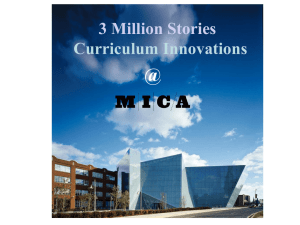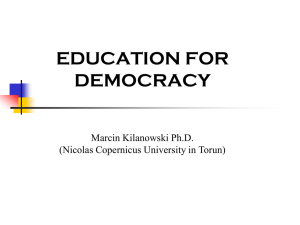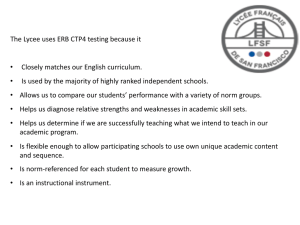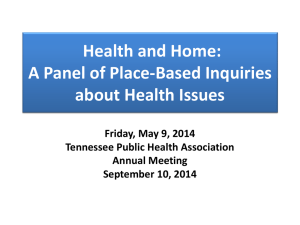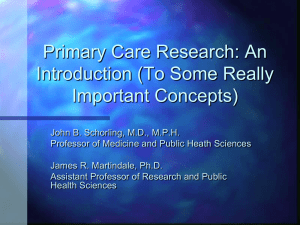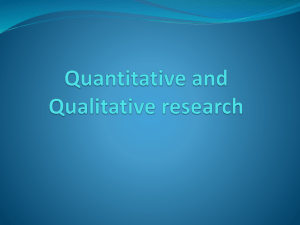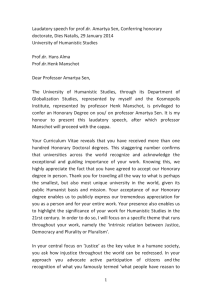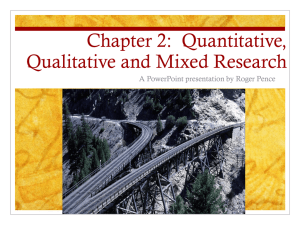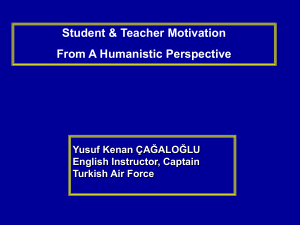ses9 - Dr. McLaughlin`s Classes
advertisement
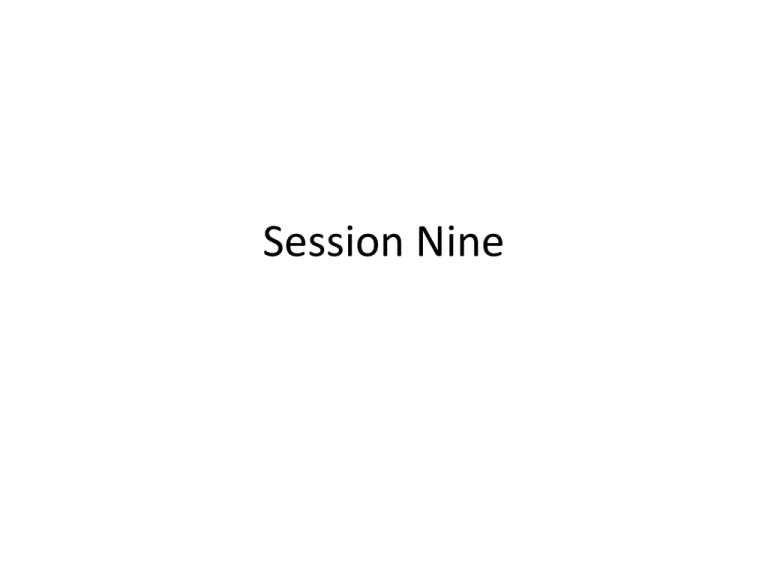
Session Nine Evaluating the Curriculum • Simply put, curriculum evaluation determines the value of the curriculum for the students • It also can measure if educational psychology principles are being used • Most evaluation measure measure achievement, there is a call for measuring thins like creativity, compassion, commitment ad enthusiasm Evaluating the Curriculum • Those that call for measuring things like creativity, compassion, commitment ad enthusiasm are against the curriculum being measured by test • However, test provide clear evidence of what students did The purpose for evaluation • Ideally there would be multiple measures throughout the year to evaluate the curriculum rather than just relying on just one • The disadvantage is that you would waste weeks testing – The PSSA take almost two weeks and if you did that three times you would lose over a month of school The purpose for evaluation • Curriculum Evaluation look at whether the curriculum is producing the desired results • Does it get the students to produce at the level expected? • Parents and teachers want to know how their students/children compare to the rest of the state or nationally Activity • What are some forms of assessment that can be used to measure curriculum? • Discuss in your small groups The Purpose for Evaluation • Means of Assessment – – – – – – – Written tests Review of students work Review of portfolios Observing students Questionnaires, Checklists Inventories • Video performances • recorded lessons • Analyses of lesson plans The Purpose for Evaluation • At the classroom level, a great deal of qualitative and informal data is used to interpret • Quantitative can be used as well What do you look for? • Four types of information – Intrinsic – Instrumental – Comparative – Decision value What do you look for? • Intrinsic – Is the curriculum using best practices that are most up to date – Have teachers kept to the goals of the curriculum What do you look for? – Instrumental • IS the curriculum reaching who it was suppose to reach • Is it doing what it is supposed to • Will it accomplish what it is intended to do What do you look for? – Comparative – This is when it is compared to another program or curriculum. Is it better – what parts are weaker What do you look for? – Idealization what ways can we improve the curriculum – Are there other ways to make the program better What do you look for? – Decision Value- is the final part, most important – Decide if you keep curriculum as is, – Modify it – Discard and get a new program – This part is ongoing Activity • If you were put in charge of evaluating a curriculum • What are the things you would evaluate • Think of when you were in school. What do you look for? – Decision Value- is the final part, most important – Decide if you keep curriculum as is, – Modify it – Discard and get a new program – This part is ongoing What is Evaluation • Some define it simply as gathering data to make a decision • The formal determination of the quality, effectiveness, or value of a program • Others see it as a critical inquiry, studying phenomena so as to make informed judgments What is Evaluation • How does measurement differ from evaluation • Define this in your groups? Measurement vs. Evaluation • Measurement is assigning a numbers or numerals to something • The score was a 20 • The score was a 95 • Which is better Measurement vs. Evaluation • Evaluation is assigning a value to that number • The score was a 20 out of 20 • The score was a 95 out of a 100 • Now can you tell Which is better Measurement vs. Evaluation • Measurement enables educators to record students’ degree of competency • That is not enough, educators must bring meaning to that number, what is enough, what is good what is not satisfactory • A PE teacher has a child do pull ups, how many are satisfactory • How many words a minute (reading) is adequate? Several Approaches to Evaluation • In most cases the one method to evaluate a curriculum can be used with other subjects, most are not content specific • Basically-gather data and compare it to the goals of the curriculum. Did you meet them Several Approaches to Evaluation • However, how people evaluate data and compare it to the goals of the curriculum varies on their educational philosophy • A behaviorist would look to see if the students can perform the designated behaviors established as by the curriculum • Humanist may be looking to see if a child’s self esteem improved Several Approaches to Evaluation • However, how people evaluate data and compare it to the goals of the curriculum varies on their educational philosophy • A behaviorist would look to see if the students can perform the designated behaviors established as by the curriculum • Humanist may be looking to see if a child’s self esteem improved Several Approaches to Evaluation • In general, educators make one of three decisions related to the curriculum – Maintain it as is – Revise it – Replace it Several Approaches to Evaluation • In general, educators make one of three decisions related to the curriculum – Maintain it as is – Revise it – Replace it • Assess students and teachers in terms of instruction and learning • Decide whether the existing managerial organization of the school should be maintained Several Approaches to Evaluation • Evaluation can take place at many levels • • • • • • Nationally State District School Grade Course Scientific or Humanistic • Scientific evaluators favor experimental approaches • Very similar to qualitative design methods – Control groups – Standardized practices – Random selection Scientific or Humanistic • Scientific evaluators focus on the learner • They use test scores and compare students based on standardized tests Scientific or Humanistic • However, many are saying that these scientific methods are not enough and do not accurately measure the quality of the curriculum • There is a call for some non-traditional evaluation procedures Scientific or Humanistic • Advocates for this type of evaluation, claim that Nontraditional evaluation procedures paint a more complete picture of the curriculum • The evaluation describes the benefits, it does not compare numbers • They rely on observations Scientific or Humanistic • Nontraditional evaluations, rely on qualitative methods – Purposeful selection of participants rather than Radom – Claim there are multiple realities – For years did not get a lot of credit, but certainly has value Mixed-Method Studies • Is when both qualitative and quantitative approaches to gathering, interpreting and reporting data are used together • Three types – Explanatory design – Exploratory design – Triangulation design Mixed-Method Studies • In order to be considered a mixed study it needs to contain a significant portion of two designs and have an impact on the work If a qualitative design only used random sampling it still would be considered qualitative or if a quantitative included a few open ended questions on a survey, it is still is considered quantitative. Explanatory Design • Most common type of mixed-method design • The study is conducted first as a quantitative study, data is gathered and interpreted as a quantitative study….Then qualitative data is collected to shed a greater light on the findings of the quantitative study Exploratory Design • This design a qualitative study is conducted first. The purpose is to discover themes and language. Then a quantitative study is built around the themes or surveys are developed with language uncovered. Triangulation Design • In this design, both quantitative and qualitative studies are carried out at the same time and the results are used to verify the work of the other study. Humanistic Approaches • Five major humanistic approaches – Interpretive • evaluates the program in its social context, gives meaning to the actions of the people involved – Artistic • The curriculum is observed and announces what is good or bad about the curriculum, looks at the quality of the relationships – Systematic • The most objective of the method, tries to be objective with descriptions, tries to use logical reasoning, but does not rely only on statistical data Humanistic Approaches • Five major humanistic approaches – Theory driven • Compare curriculum to a variety of philosophical theories – Critical-emancipatory • Judge curriculum on how well it counters social forces that impede an individual’s progress Utilitarian versus Intuitionist • Utilitarian takes the look at a curriculum based on how efficient it is in helping a large group of students- programs that allow the most students to achieve would rate well • The intuitionist approach judges a program’s impact on a small group or on the individual Intrinsic vs. Payoff approach • Intrinsic approach looks at the curriculum itself-the assumption is, if the plan is good, then it will work • The payoff approach looks at the difference in scores between when students started on a program and when they finished a program – Pre and post testing Formative and Summative evaluation • Formative – Are activities taken to improve an intended activity – Carried out during program development – Provides evidence that will direct the curriculum writers during the writing of the curriculum – Uses sub units in a pilot or pretrial situation – Provides information to either adjust, keep or get rid of portions Formative and Summative evaluation • Formative • In phase two, various activities are done to determine if if they have value, does it achieve its intended purpose ( after the pilot) • Final phase- the curriculum is field tested- it is evaluated as it is taught to the students Formative and Summative evaluation • Summative- poses the question has the curriculum worked- done after the curriculum has been implemented • Has four levels of evaluation – Level One-How did the students react, was it as anticipated? – Level Two- Have the students gain the knowledge intended? Formative and Summative evaluation • Summative– Level Three-Can the students employ the newly acquired skills? – Level Two- Evaluate results- difficult- sometimes a focus group is used for this Evaluation Models • There are two Scientific Models – Congruence-contingency Model – Context, input, process and Product model • There are Two Humanistic models – Connoisseurship and criticism Model – Illuminative Model Evaluation Models • • • • • Congruence-contingency Model Focused on using objective data to make decisions The sue of formal process are emphasized Data was important in this model Three are three types of data • Antecedent Data • Transaction • outcome Evaluation Models • Congruence-contingency Model • Antecedent Data- is any condition that existed prior the teaching and learning took place that may have an impact on an outcome – Includes- aptitudes, previous achievement scores, psychological profile scores, Discipline and attendance, teachers years of teaching and teacher behavior rating Evaluation Models • Congruence-contingency Model • Outcome – includes students achievement and sometimes student attitudes and motor skills • These outcomes are measured against what was anticipated and planned for. Where they are different explanations are sought or the curriculum is modified Evaluation Models • Context, input, process, Product • Context- study the program in the context or environment it was used-does it matched the desired or portrayed conditions – Then you focus on un met or missed opportunities • Input- provides input regarding resources – – – – Were the stated resources allocated Is there a way to achieve the goal with fewer resources Are the instructional practices appropriate? Are their other strategies that could meet the objectives? Evaluation Models • Context, input, process, Product • Process- looks at implementation decisions that control or mange the program – Detect or predict defects – Gain information to make decisions • Product- occurs during implementation- it is a piloting process that allows you to debug – Is the final program delivering what it is intended to do? Humanistic Models • Does not rely on quantitative data • More holistic • Focuses more on human interaction than on outcomes Humanistic Models • Connoisseurship and the criticism model • Both models are designed to produce a rich description of educational life as a consequences of a new program • It is a very qualitative method Humanistic Models • Connoisseurship – Is a personal process. The report is either done by or for the practitioner – It examines, curricular design, instructional practices, material Humanistic Models • criticism model– Works in a similar manner. Uses observation to examine all parts of the curriculum, but the report developed is reported publicly Humanistic Models • Illuminative model – Sheds light on a program as it functions – It has three steps • Observation- observers give and overview of the program and give a context for which it is being delivered • Further Inquiry-evaluators separate the significant from the significant and seeks to determine whether the program works and why or why not • Explanation not a judgment process, but furnish data about what is happening Action research Action Research • Action Research is the most popular type of research now being done with teachers in schools • It is at the far end of the continuum, full participation • Ideally once it is up and changes have been made, researcher can leave, and let the changes be implemented by the others involved that will remain on site Action Research • Three main types – Practical Participation – Participatory Action Research – Action research as a revolutionary Act- Not going to cover- Action Research • Practical participation – Have a setting that needs improvement, or a problem that needs fixing. – There is a plan that is believed can fix the problem Action Research • Practical Participation – plan is developed to treat the PROBLEM – The researcher, working with others, implements the plan – Data is collected to see if the plan worked. Action Research • Practical Research • Example- Students are entering first grade with poor phonetic skills • Theory- student have poor phonemic Awareness and are having difficulty because they are not ready to learn phonics • All Kindergarten students spend time on a phonemic awareness program • As children enter first grade, scores are measured. Compared with the classes progress as well as to other classes Action Research • Participatory Action Research • This type of research takes a similar course as the practical research. However, it is with a much more serious situation • Involves changing attitudes of teachers or students Action Research • Participatory Action Research– Instead of a simple plan, research is first done to determine the problem – Then a plan is developed – Then the researcher oversees the plan being implemented Action Research • Finally, the plan is evaluated to measure its effectiveness. • Examples, Changing racial beliefs- creating greater understanding about interacting with minority students and minority student interacting with non-minority teachers. Evaluation Steps • Focus on the curricular Phenomena to be evaluated • Collect the information • Organize the information • Analyze the information • Report the information • Recycle the information- it is on going so keep doing it High Stakes test • Standardized so they can be compared • Controversial – What are some of the issues Norm-referenced Approach • Is when scores are compared to a reference group or a norm of others that have taken the test. The reference groups usually has the same characteristics such as age, or grade • Performance is described in relation to position such as a percentile rank. 60 percentile mean that a child scored as well as or better than 60 % of the norm group Norm-referenced Approach • Some norm-referenced test show a rank for a national score as well as a local score. Sometimes in very good or very poor districts, these can be very different Activity • If a child had a 40 percent locally and a 85 percent nationally, is this the sign of a high or low achieving school district • You are in a meeting, Describe to a parent what this means • It means that 60% of the students in the district scored at or above the 85th percentile nationally. Norm-referenced Approach • Norm-referenced test can show a high variation between different levels and be used to sort for homogenous grouping ( Not in very high achieving districts) • Minorities are sometimes over represented . There is a higher percentage included to make sure the groups is represented accurately Criterion-referenced Measures • These measures compare a child to some established standard or level of performance or skill. • Not great for separating student if a lack of variance among scores exist Standardized Measures • A uniformed procedure for administration and scoring of test has been established and must be followed. • Prepared commercially by experts • Care has been given to reducing cultural bias, validity, reliability and bias • Not great for evaluating local curriculum in areas of science and social studies Standards-Based Tests • Are based on principles of criterion referenced test • They are “Domain referenced- questions drawn from a larger domain of knowledge • Typically judged by levels such as proficient or not-proficient. • Used to evaluate schools • Referred to as high stakes tests Standardized Achievement Test • Most are norm referenced although some are criterion referenced • Must select appropriate test for task • Several types – Diagnostic – Achievement – Batteries Standardized Achievement Test • Diagnostic tests– Identify specific strengths and weaknesses in a particular discipline or area- IRI, QRI, Math Inventories • Achievement– Measure achievement in a single subject or area • Battery – Measure achievement in several areas Scores from Norm -Referenced Measures • Grade equivalent • Indicates how an individual compares in a normative group in terms of grade level • 5.0 is the average score of a norm group at the stat of fifth grade • 5.2 is the fifth grade Second month ( November( September -.0, October -.1 November.2, december-.3, January-.4) Scores from Norm -Referenced Measures • Standard Score- Is based on o to 99.9 The closer to 99.9 the higher the score. – Many times a standard score uses 100 as the mean, and 15 id the standard deviation • It is based on a Z-score, with a mean and three standard deviations on either side • 50 Is mean +1sd=84, =2sd=98, =3sd=99.9 • -1sd=16,-2sd=2,-3sd=.1 Standard Scores • Standards scores are used frequently and the mean can be determine arbitrarily as well as the standard deviation • SAT Mean = 500, +1sd=600, +2sd=700, +3sd=800, -1sd=400,-2=300,-3sd=200

